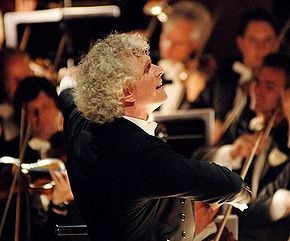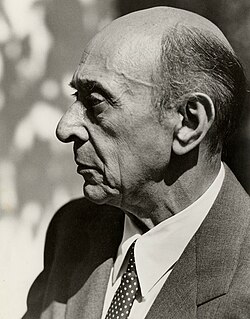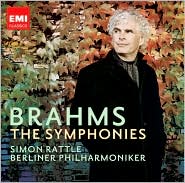It is a pleasure to be in Ann Arbor (thank you,UMS) which enjoys such exclusivity that it is often a stop along with the “other music capitals” on the tours that the best and the brilliant artists make. The pleasure turned into pure bliss when the Berliner Philharmoniker was in town yesterday.

The Berliner Philharmoniker, one of the oldest as well as the best orchestras of today, is currently on a coast-to-coast seven-stop U.S. Tour. In September 2009, the orchestra released a recording of Brahms Symphonies (four in total), conducted by Sir Simon Rattle. Hence on the U.S. tour, these symphonies play the centrepiece of their concerts along with Brahms’ other compositions and Schoenberg’s (an ardent lover of Brahms) creations too.
Sir Simon Rattle conducts with such precision and clarity (probably as was an orchestral percussionist himself) that even the listener will attune his emotions to the conductor’s movements (or so I felt). A far-sighted visionary with big plans for the Berliner Philharmoniker, Sir Rattle is one of the main supporters of the Digital Concert Hall (I love this concept, check it out).

- Sir Simon Rattle
Now back to the performance.
Brahms’ Symphony # 3: the first piece of the evening
This symphony, in F Major is such a beautiful piece. First, a little on the structure of the symphony. The first movement ( in the tempo allegro con brio) starts very vigorously with a three note opening, the energy of which startles the listener, making him sit up straight and pay attention. There is a brief lull where the strings play an expressive melody and the opening theme comes back with full vigor. The notes go back and forth between the major and the minor modes. The theme is recurrent and there is a sense of foreboding and urgency.
The second movement is a slow one with a recurring theme, almost conversational, I feel. The horns,bassoons and the strings seem to be having a dialogue. There are many variations of the theme and it borders on being sad in a restful quiet way.
The third movement is faster and more melodious. I LOVED this the best. There is a mode change and the theme is briefly optimistic before returning to a sad melody.
The final fourth movement starts in hushed tones. But then suddenly, you hear the theme from the second movement, with the dynamics completely different this time, played in a loud confident manner. The ending is soft and inconclusive.
In this symphony, there isn’t much percussion. But then the staccatos and the abrupt note changes of the strings almost keep a rhythm going. There are so many layers of emotions to this symphony that it is unbelievable.

My interpretation of symphony No.3
As I was listening to the symphony, I could imagine a story unfolding. The first movement starts with news of the war (the brisk energy). There is panic and the womenfolk mumble softly among themselves (the strings). Then the Prince leaves along with the warriors (the resounding ending).
The second movement is about the conversations of the womenfolk left behind. The Princess and her friends talk among themselves about their men. There is talk of separation( the quiet melancholic tone) and of pride in the Prince’s valor ( the buoyant tone, especially of the horn). I also “saw” the mixing of the sad and buoyant tones this way- “Someone was about to burst into tears but then they changed their mind as if they suddenly remembered something to be happy about.”
As for the third movement, news from the battlefield returns and the town is mourning for the lost Prince, also feared to be dead (the almost sad theme). There are some rumors that he might be alive (the minor-to-major mode change). But then that is not so and the princess mourns along with her subjects (the main melody played by the horn and taken by the string section).
In the finale, they are still mourning (hushed voices). There is more sadness (theme from the second movement). There is finally good news that the Prince has returned triumphant and all rejoice (the resounding trumpets and the entire orchestra). The princess tells the Prince about what she went through (the second movement theme again) and there is a quiet and thankful rejoicing (the first movement theme returns). It all ends with all wondering if there would be another war (the mysterious ending).
Back to the performance
Moving on to the performance of the Berlin Philharmonic in particular, their rendition of Symphony #3 was out of the ordinary. I was seated in the second row and I could see the players so close. They were completely one with the music (some were playing it by heart) and I felt that the beauty of Brahms’ work shone through purely because of the conductor’s and the musicians’ interpretation. In this symphony, the horn, bassoon and the contrabassoon hold such a key part and the players were absolutely brilliant. The string section was of course amazing too.
Arnold Schoenberg’s “Begleitmusik zu einer Lichtspielszene”
After a 20 minute intermission, the orchestra treated us to one of Schoenberg’s works.

Titled “Begleitmusik zu einer Lichtspielszene” (music to accompany a film scene, this was so different. It is a perfect example of Schoenberg’s 12-tone system and it was disturbing. It had three sections- danger, fear and catastrophe. The first thing that came to mind was that it was perfect background music for a classic Hitchcock movie, especially “Birds”.

Brahms’ Symphony No.4
Next, the orchestra performed symphony #4 in E Minor. This was Brahms’ final symphony and is considered one of his most celebrated works.
To me, the first movement was the many bests of the evening. There are two themes (rhythmic and lyrical) to this one that keep entwining about one other, one soft and the other energetic and the final coda is an explosive outburst that brings the two themes together. I absolutely loved the soft melody of the strings and the exuberant end of this movement. The second movement also has a similar thing going on.
The third movement, the only real scherzo of Brahms’s symphonies, is so energetic and triumphant.The clarity and sharpness given by the timpanist as well as violins was so clear here.
The fourth movement is like a roller coaster ride- with a initial bass theme followed by one of the most beautiful violin melodies and then a resounding crescendo. Then the tempo slows down and there is a flute solo followed by other solos while the violins are softly playing in the background. In the end, we hear the turbulent opening theme of the finale again and there is a somewhat sad ending that leaves you wanting for more.
And we wanted more too as we pleaded in vain with Sir Rattle for an encore. Alas, we didn’t get an encore and while I believe in moderation- in-everything, it definitely does not apply to doses of divine music like these.
Krithika, [art]seen reviewer
Krithika is still in heaven after the night’s performance and will resume earthly duties only when it is absolutely impossible to procrastinate any further. 🙂



thanks alot